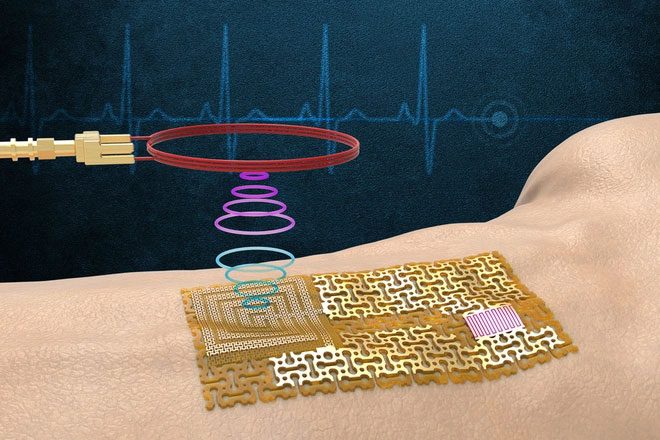Engineers from MIT have invented a new wearable sensor that can communicate wirelessly without the need for integrated chips or batteries.
Today, wireless wearable sensors have become familiar devices in daily life. Thanks to these sensors, users can access comprehensive information about their personal health, including glucose levels, blood pressure, heart rate, and daily activity intensity.
A MIT engineer and his collaborators recently published research on a new flexible skin sensor. The design, published in the journal Science, promises to be a breakthrough towards wireless sensors that do not require integrated chips.
Unlike popular wearable devices today, its design is extremely minimalist and utilizes surface acoustic wave technology to wirelessly transmit health data.

Minimalist wearable sensor without batteries or memory chips.
The most significant advantage of this invention is its snug fit, similar to a band-aid, allowing users to monitor their health without the need for additional components like memory chips or batteries.
“It’s very thin and light, an incredible combination. You will feel like you’re not wearing anything on your wrist,” inventor Yeongin Kim stated.
This new sensor is a flexible semiconductor, conforming to the skin like a band-aid. Its internal components include a high-quality, ultra-thin gallium nitride layer. This semiconductor material is known for its piezoelectric properties, generating electrical signals in response to mechanical deformation and vibrations, as well as reacting to electrical pulses.
From this principle, the researchers found it entirely feasible to harness the two-dimensional piezoelectric properties of gallium nitride and utilize this material for both sensing and wireless communication.
The idea from Kim’s team originated from addressing user discomfort when wearing sensors for extended periods. Most current wearable sensors typically use integrated circuit chips made from rigid, inflexible components, requiring thicker support materials like rubber to adhere to the skin. Meanwhile, sweat tends to accumulate beneath the plastic and rubber layers.

Inventor Yeongin Kim and the product that promises to revolutionize next-generation sensor devices.
“Thousands of transistors in an integrated circuit consume a lot of power. If you want more accuracy, you need to consume even more power. That is the fundamental limitation of the integrated circuit approach. A lot of heat is generated from integrated circuits. Even if it doesn’t cause harm, it can be uncomfortable for users,” Dr. Kim explained.
Kim noted that this new wireless, chipless approach allows users to comfortably wear the sensor for long periods without any discomfort. “It’s very comfortable and stretches well. My device feels like a part of our skin,” the MIT alum excitedly revealed.


















































